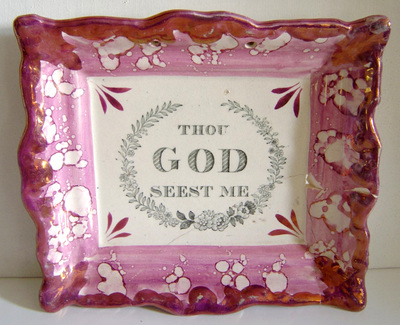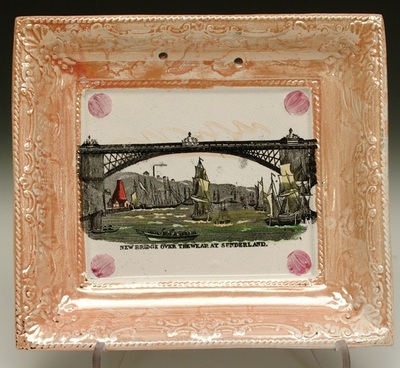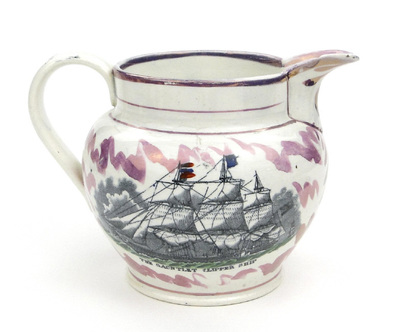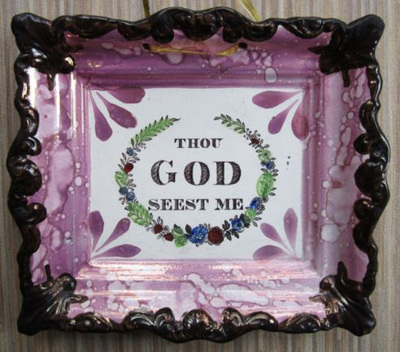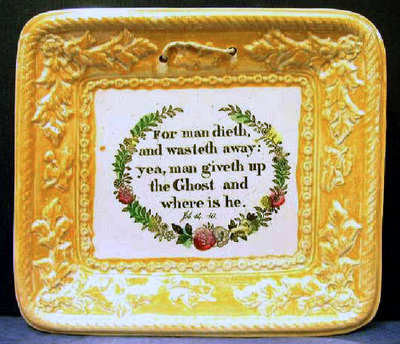|
6/28/2014 0 Comments Dixon's demiseThe Garrison Pottery's closure in 1865 is helpful for dating plaques. That year, the transfer plates were sold, likely at auction, along with Dixon's other effects. So any non-Dixon plaque, with a Garrison transfer, has to have been made after that date. Baker references a transfer plate, presented by a member of the Ball family to the Sunderland Museum, that appears to have 'passed into the hands of either Moore's or Scott's (possibly both) and finally to Ball Brothers'. The selling and recycling of transfer plates is perhaps in itself significant. Aside from the Newbottle verse transfers, I can't think off hand of other transfer plates moving from pottery to pottery on Wearside before 1865. Recycling of transfers seems to happen largely in the later period, and fits with a more cost-conscious, less inventive, approach to turning out pottery. At its height, Dixon's made fabulous quality lustreware (see below left). But by the 1860s, quality had deteriorated (centre and right) with heavy potting and degraded transfers. Even so, the transfer plates still had value, and were sold on to other potteries for reuse. Transfers that went to CarrJohn Carr & Sons, of North Shields on Tyneside, bought a quantity of Dixon transfer plates (see below, Dixon plaques left, and Carr right). Carr appears to have had the transfer plates heavily re-engraved, but mitigates that with exuberant 'clobbering' (enamel decoration) and lustre flourishes. There is another verse, 'Friendship, Love and Truth', that went from Dixon to Carr, but I don't yet have a photo of a Dixon example. It's likely that the Dixon 'May Peace and Plenty' also went to Carr (see last two plaques below), but there are minor differences between the transfers, which might be down to re-engraving. Transfers that went to ScottThe transfer plates that went to Scott and appear on the group 1 plaque form (see my last-but-one post) are fairly limited. The Sailor's Return and 'England, England' verse (first two plaques below) are two of the transfers listed by Baker as appearing on the Dixon transfer plate at the Sunderland Museum. There are 7 transfers on this one copper plate, so there are potentially 5 more variations of these rare plaques yet to be recorded (more on that, hopefully, in another post sometime). The Gauntlet Clipper Ship (Dixon version, top right) appears very rarely on the Scott group 1 plaque form (bottom left) from the 1860s. If Scott was making brown-bordered plaques at this time, why isn't the transfer found on them? It would fit very naturally in the ship group. It isn't until the orange-lustre period that the Gauntlet joins them, on the plaque form with rounded corners, also attributed to Scott (last two plaques). As discussed in my last-but-one post, the view of the New Bridge over the River Wear first appears on Dixon items (top left below), and then on the Scott group 1 plaque form (top centre and right). The transfers also pair on a jug (bottom left and centre), with very similar decoration to the Scott-attributed Farmers' Arms jug mentioned in a previous post (bottom right). There may be other transfers from Dixon that make it onto the Scott group 1 plaque form. For instance, the transfer 'Agamemnon in a Storm' frequently appears with the Gauntlet on Dixon items, and it is likely that both transfers were engraved on the same copper plate. Transfers that appear on brown-bordered plaquesLet's start with the transfer that gave the name to this website. A circular Dixon (c1860) version is shown on the left, beside a typical brown-bordered plaque (post 1865). Whoever made the brown-bordered plaques (whether Scott or Moore) clearly had an interest in purchasing the common verses from Dixon. Although the brown-bordered plaques (right examples below) were made in large numbers, there are more Dixon versions (left examples) with these transfers. N.B. the Dixon plaques are the output of much longer period: 1840-1865. The motivation for purchasing the transfer plates must have been to squeeze the last drops of commercial value from four of Dixon's top sellers. It appears to have been a canny move, as the popularity of these transfers continued into the 1870s and the orange-lustre period. Incidentally, Dixon didn't have a 'Praise Ye the Lord' transfer, so whoever produced the brown-bordered plaques appears to have had one made to complete the set (bottom left). The bottom centre plaque has a hand-painted date '1875', which helps us fairly accurately date these orange plaques. The first, circular, plaque below is of a typical Moore form. The second is the round-cornered form attributed to Scott. It is only during this orange-lustre period that there's a complete mixing of transfers on Scott and Moore forms. This ties in nicely with Norman Lowe's theory that at some point both potteries were sending their wares to the same place - Sheepfolds Warehouse - for decoration. So who made the brown-bordered plaques? You'll probably have guessed that I think this inches us a little further towards Moore. Even amongst the transfer plates purchased from Dixon, there appear to be two distinct groups. The transfers that appear on Scott group 1 items have never yet been recorded on brown-bordered plaques. What better explanation for this than they were made at two separate locations? It is only in the orange-lustre period that the transfers are used on Scott and Moore plaque forms interchangeably. Interestingly, there is no orange-lustre version of the brown-bordered plaque form.
0 Comments
Leave a Reply. |
AuthorStephen Smith lives in London, and is always happy to hear from other collectors. If you have an interesting collection of plaques, and are based in the UK, he will photograph them for you. Free advice given regarding selling and dispersal of a collection, or to those wishing to start one. Just get in touch... Archives
February 2022
AcknowledgementsThis website is indebted to collectors, dealers and enthusiasts who have shared their knowledge or photos. In particular: Ian Holmes, Stephen Duckworth, Dick Henrywood, Norman Lowe, Keith Lovell, Donald H Ryan, Harold Crowder, Jack and Joyce Cockerill, Myrna Schkolne, Elinor Penna, Ian Sharp, Shauna Gregg at the Sunderland Museum, Keith Bell, Martyn Edgell, and Liz Denton.
|


